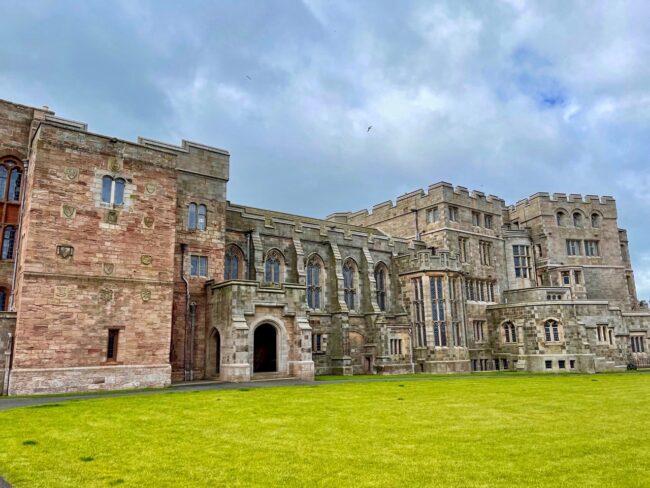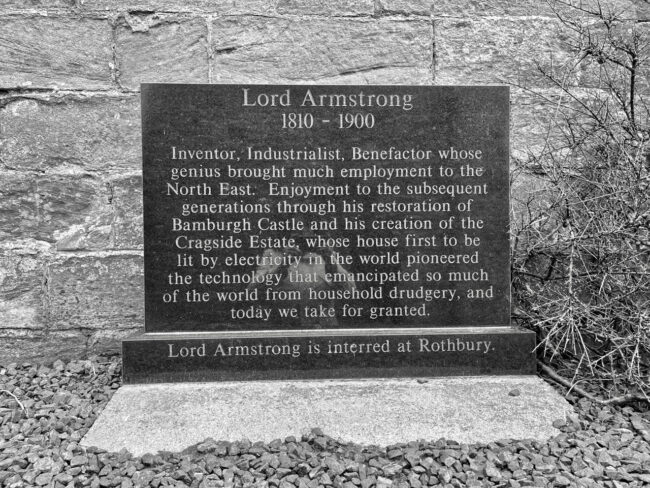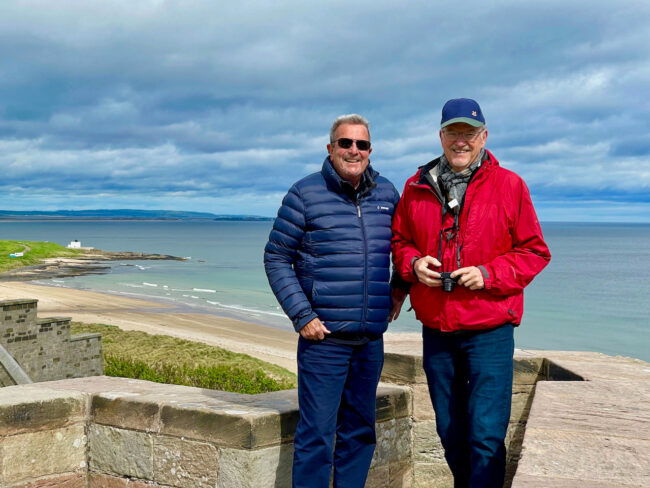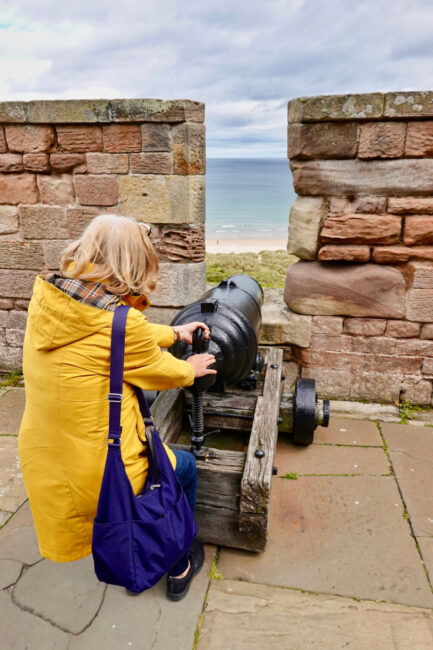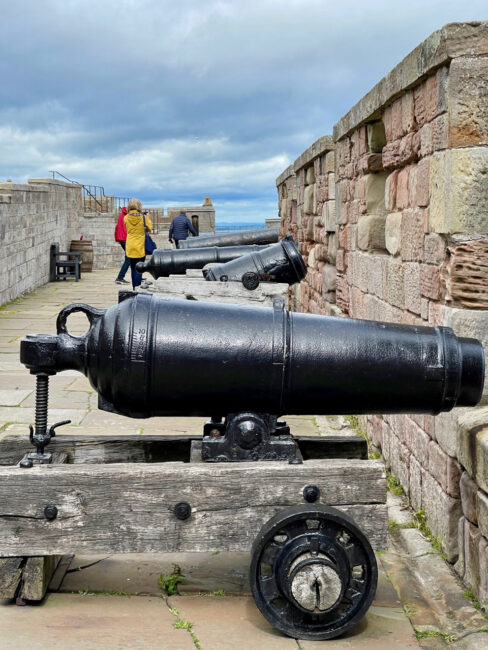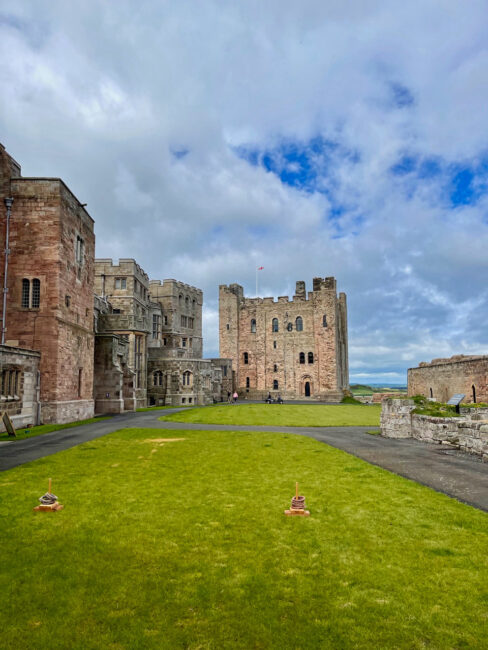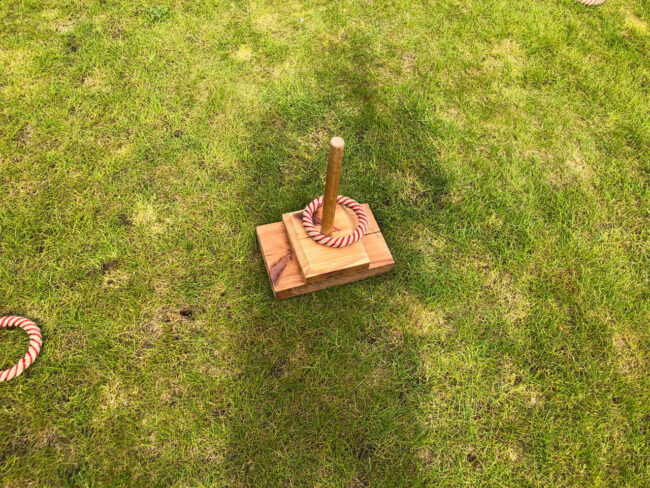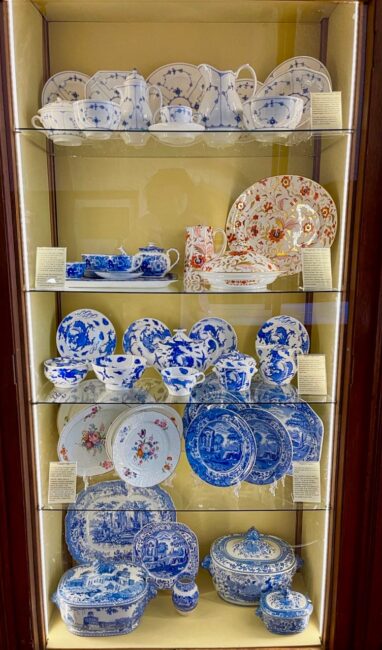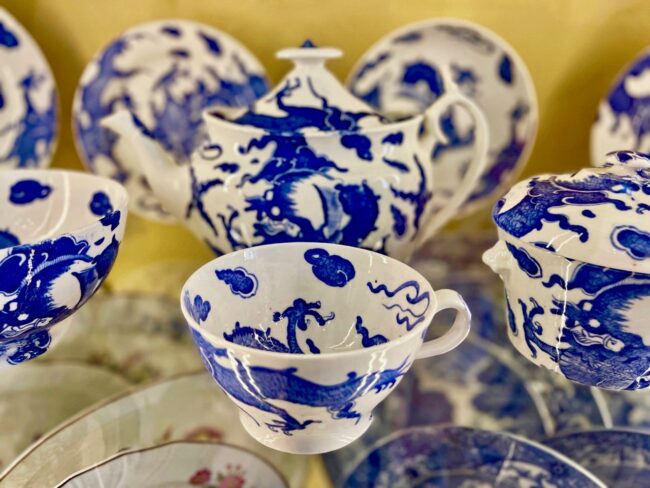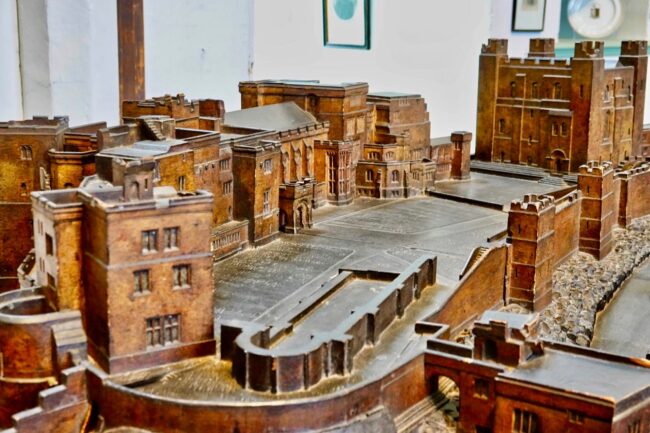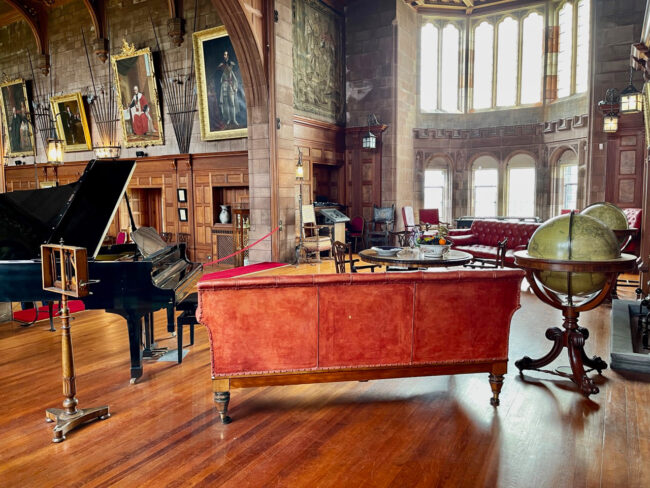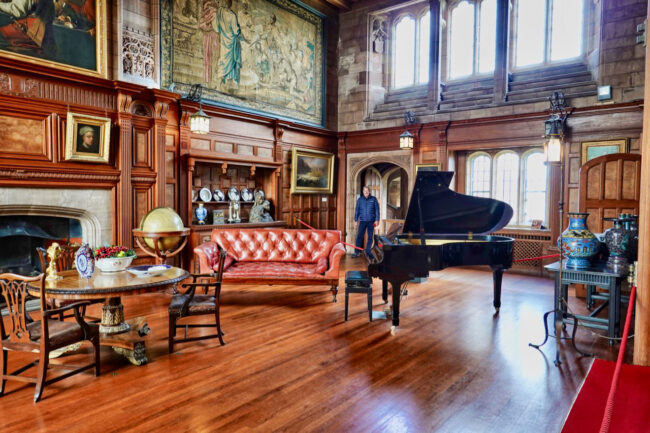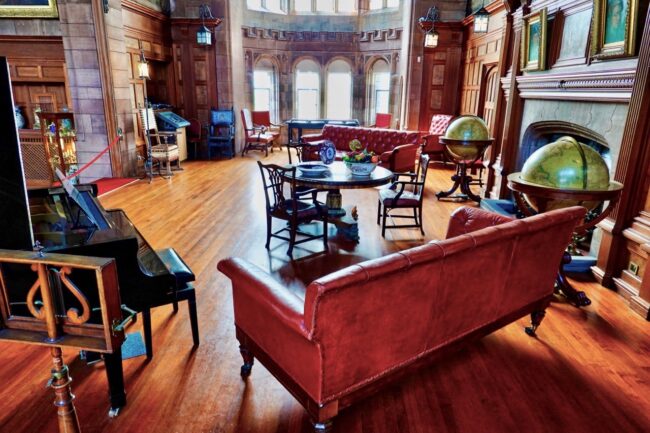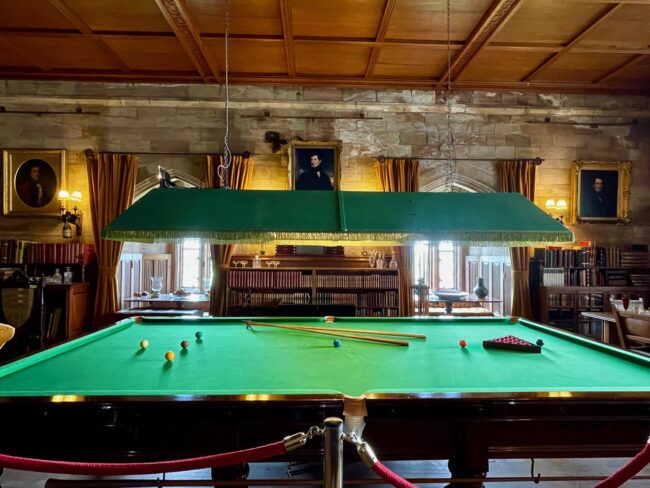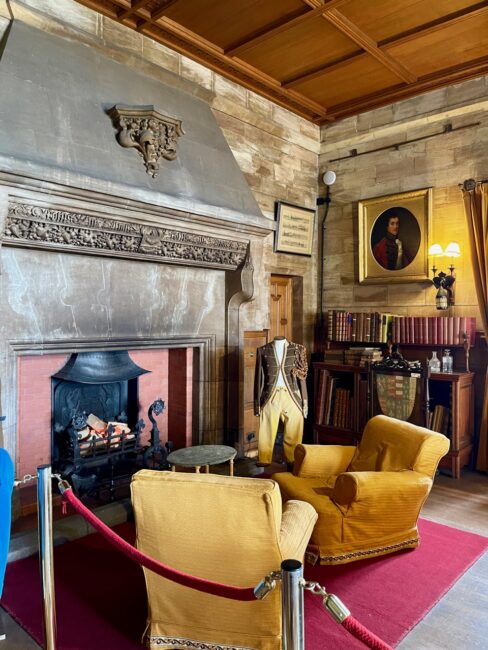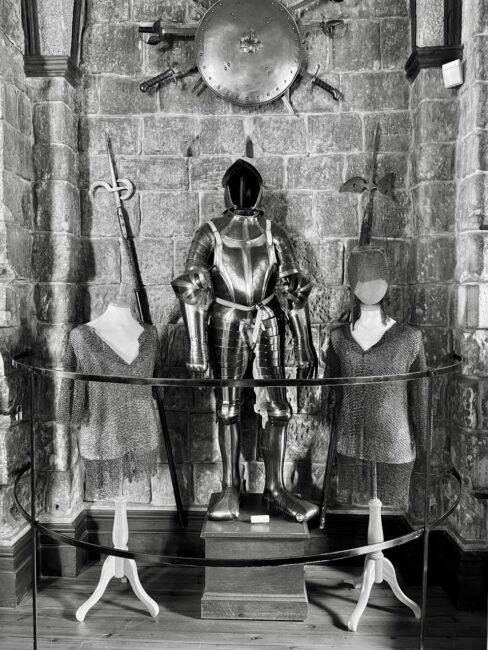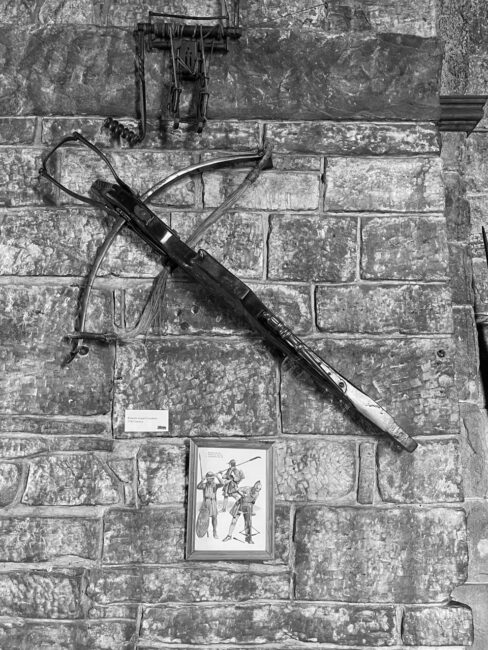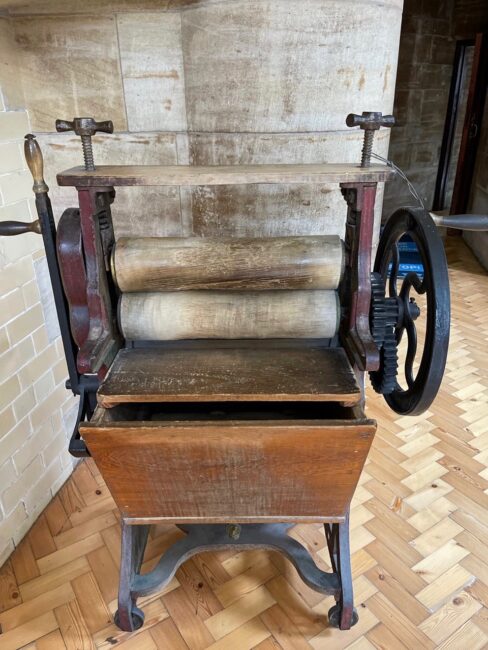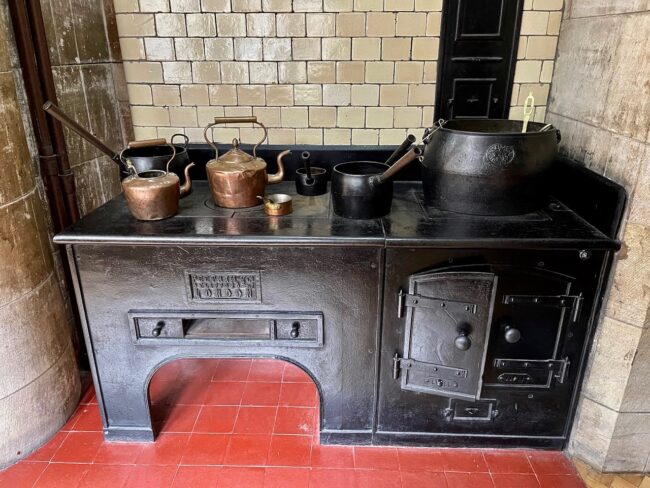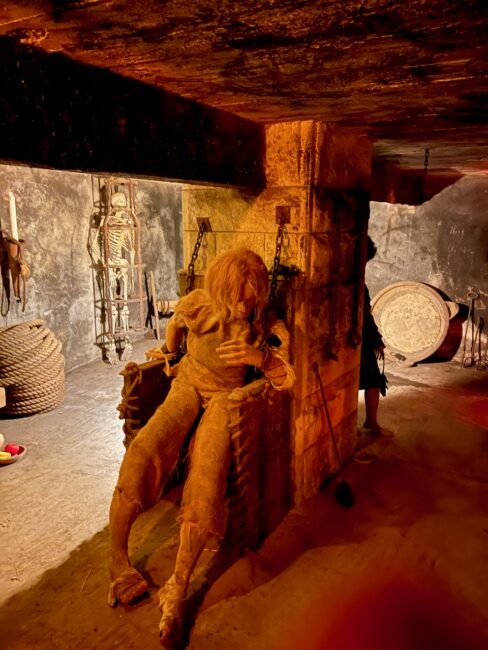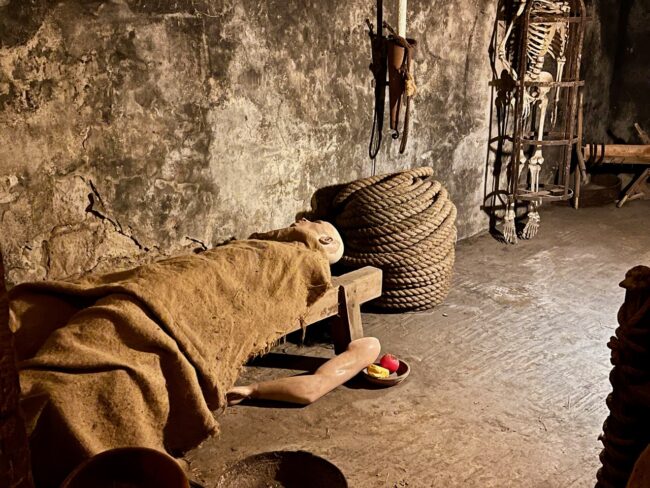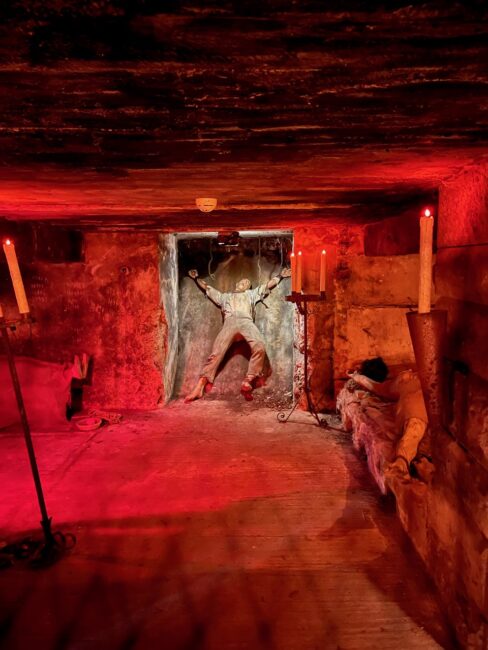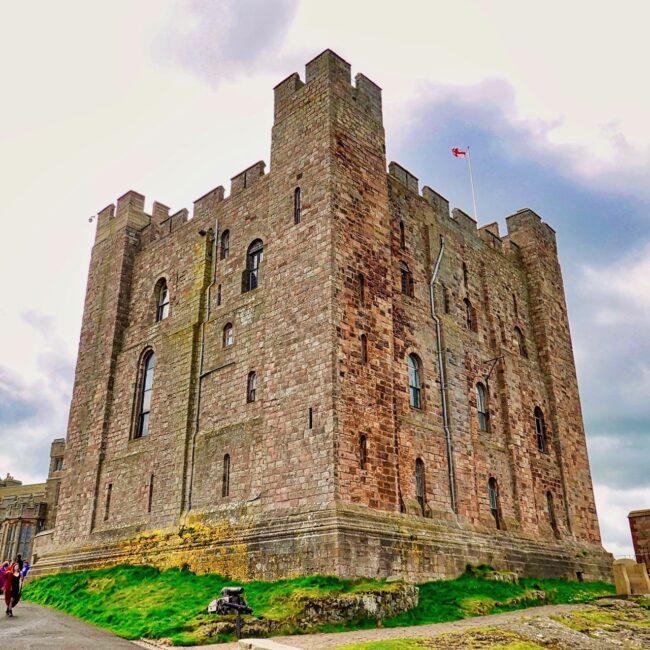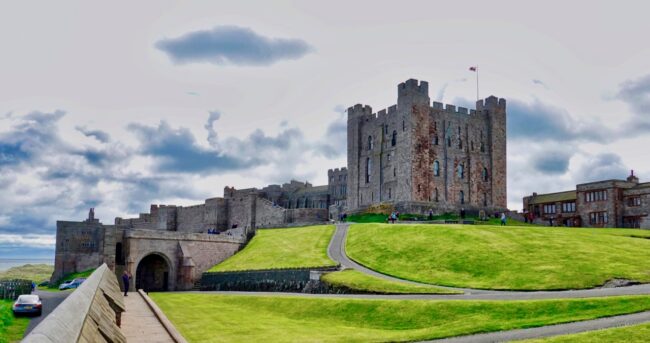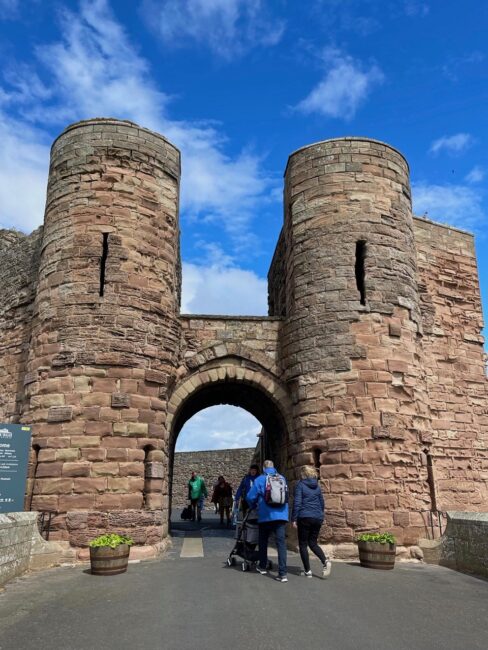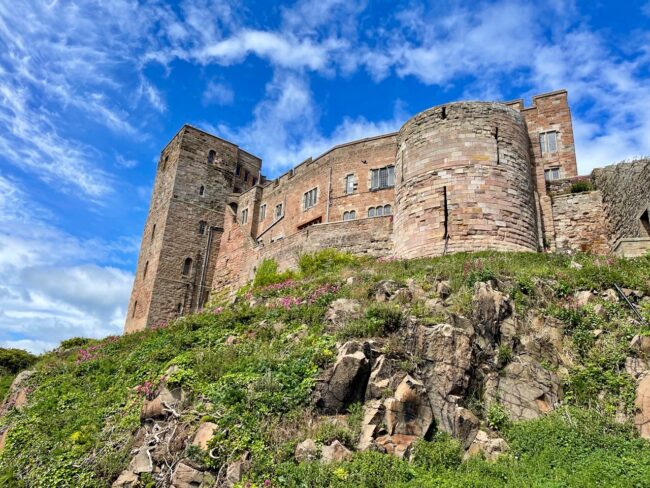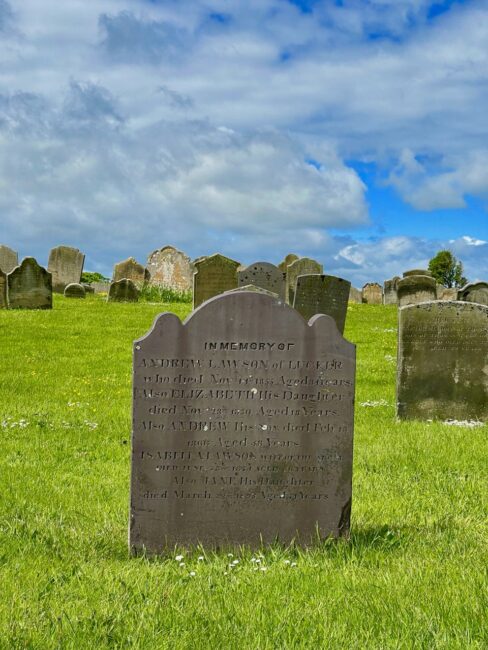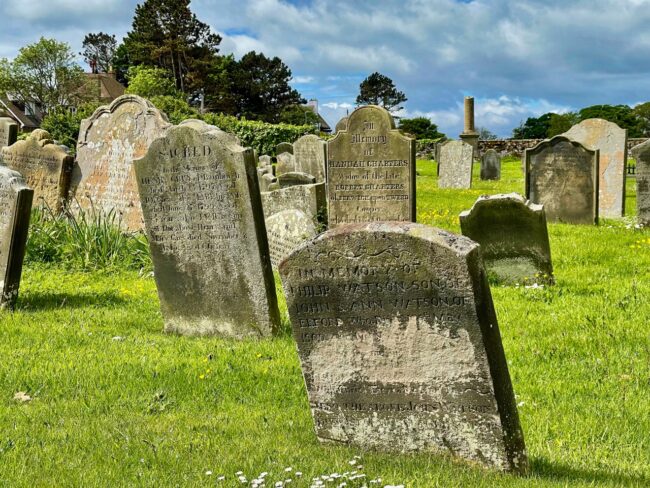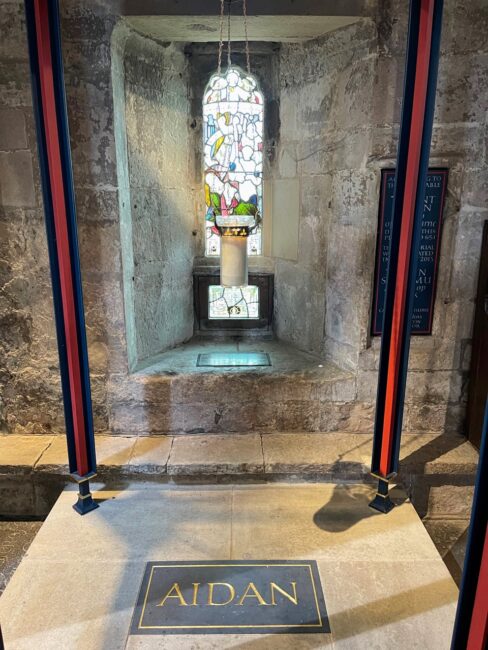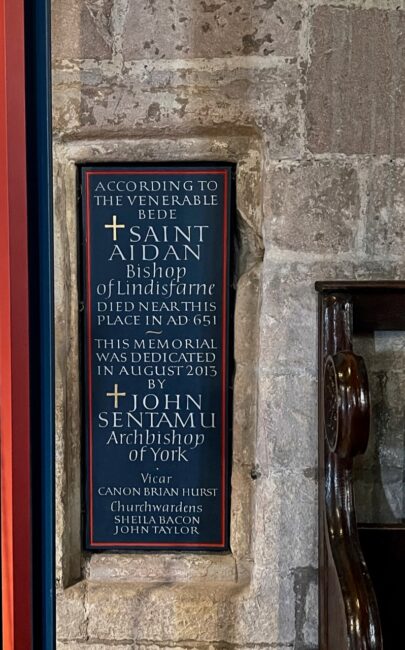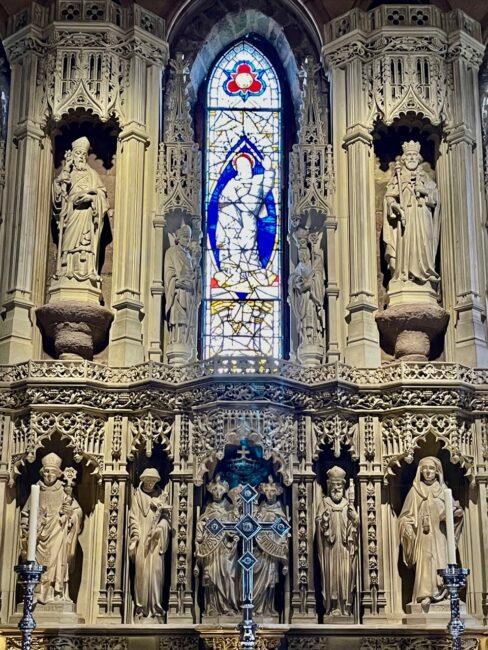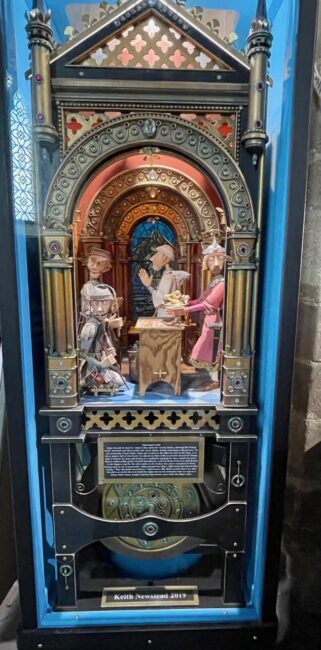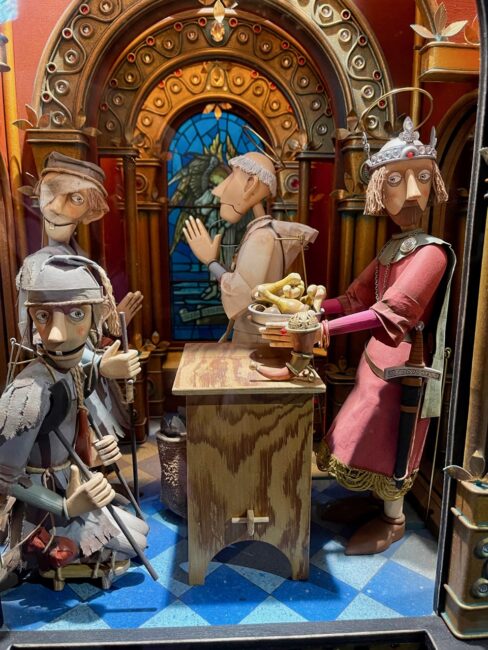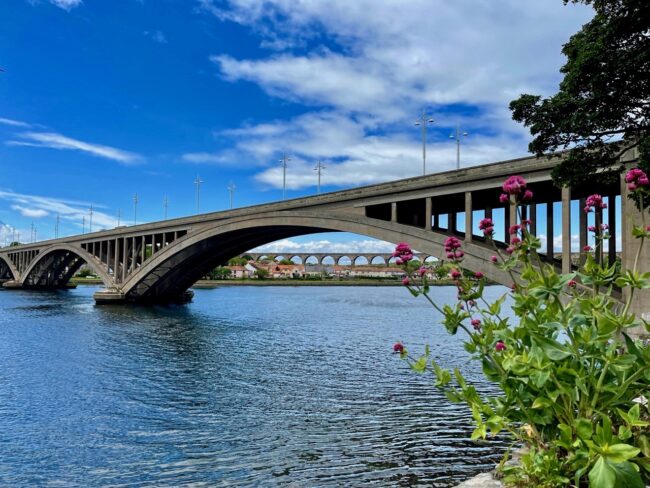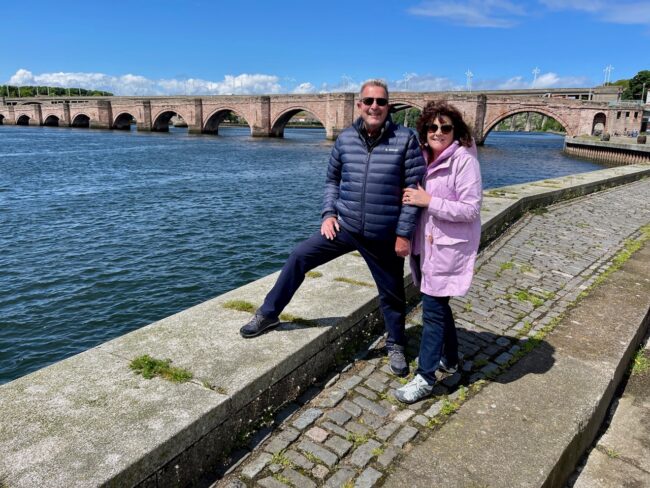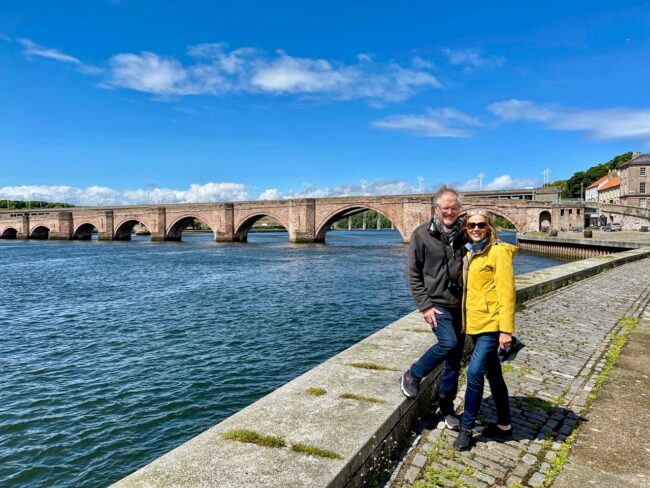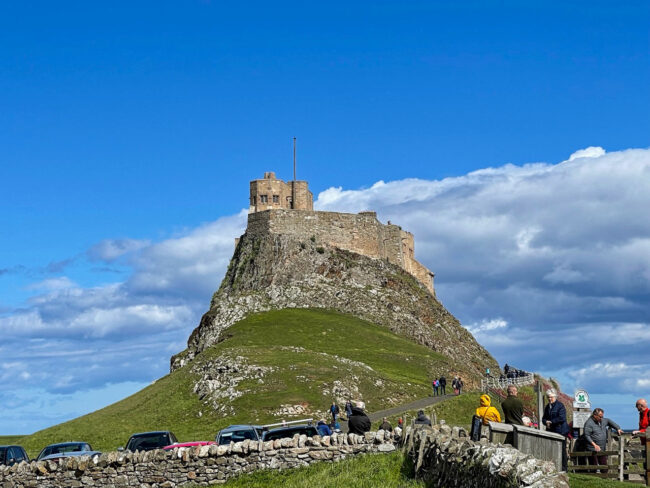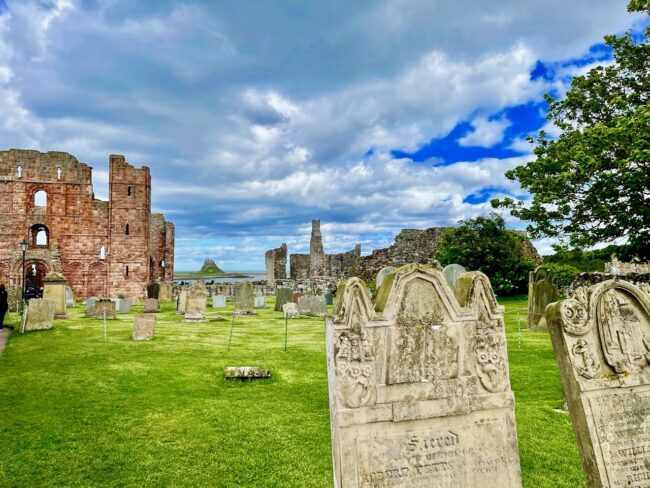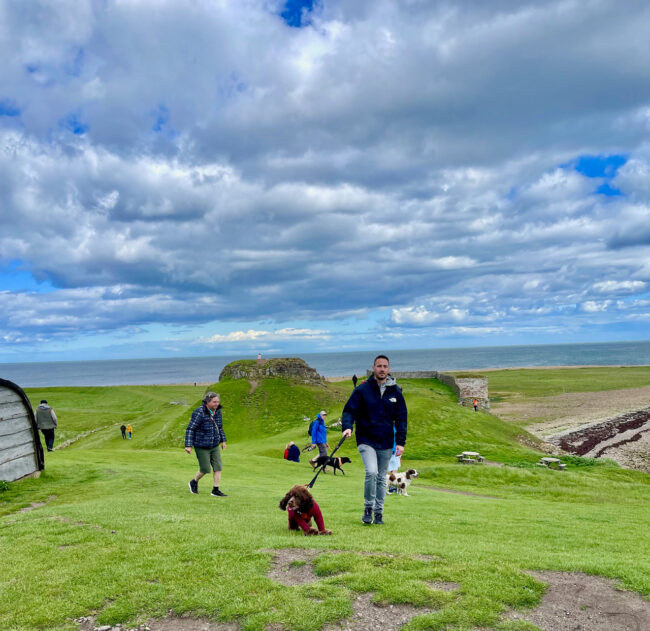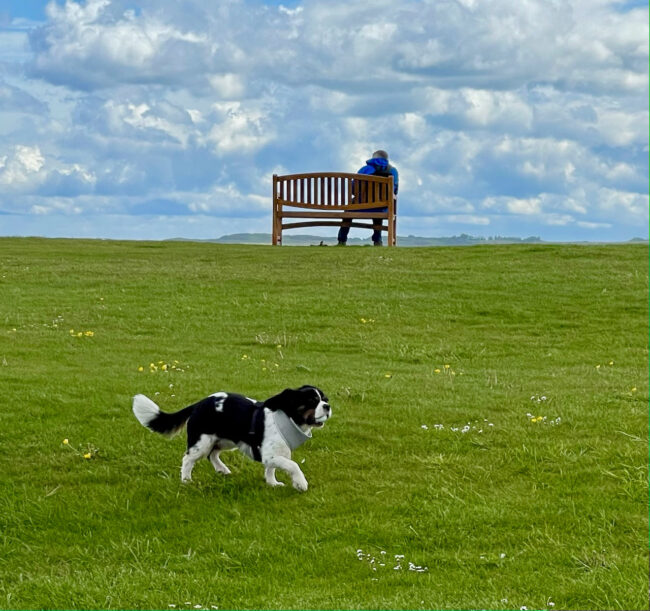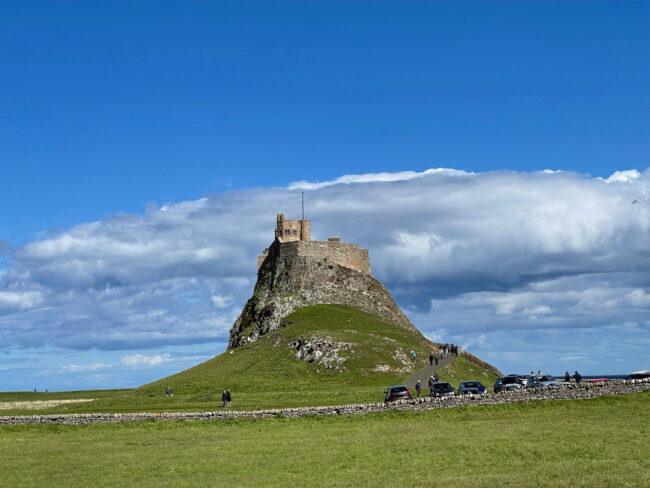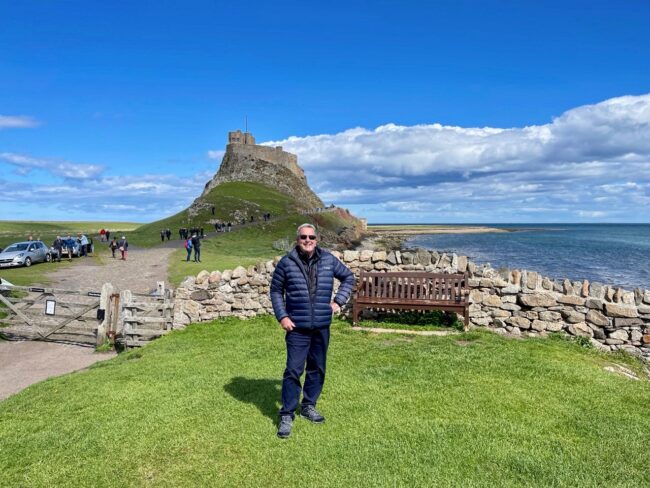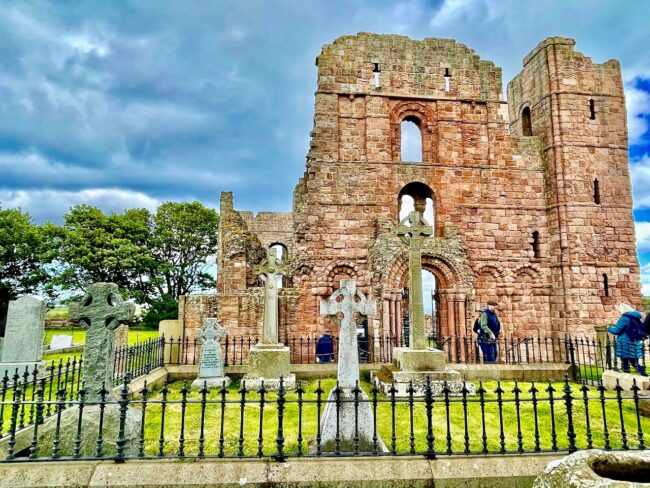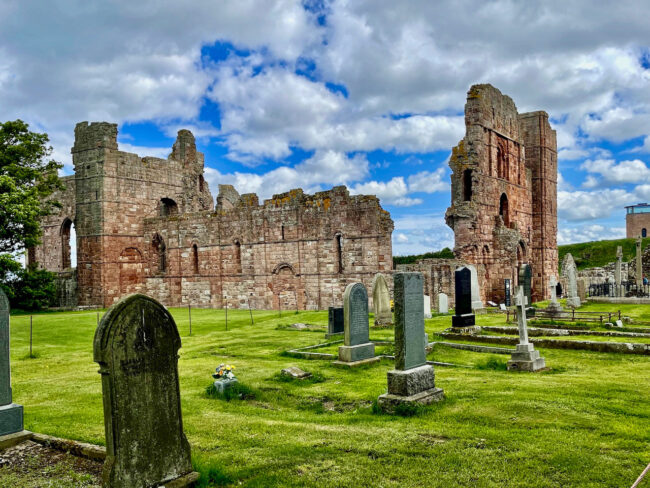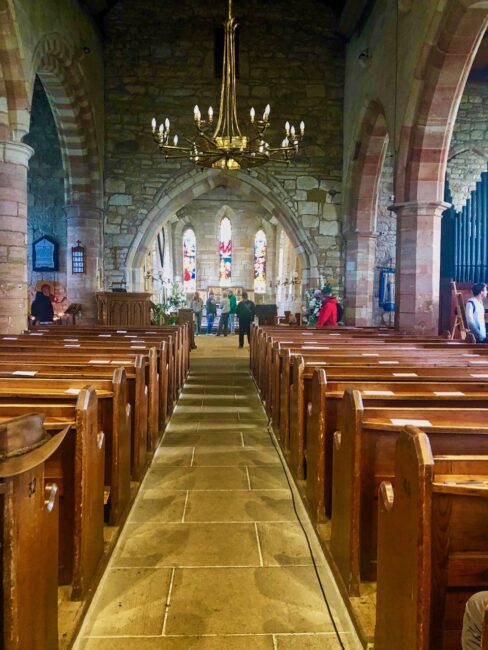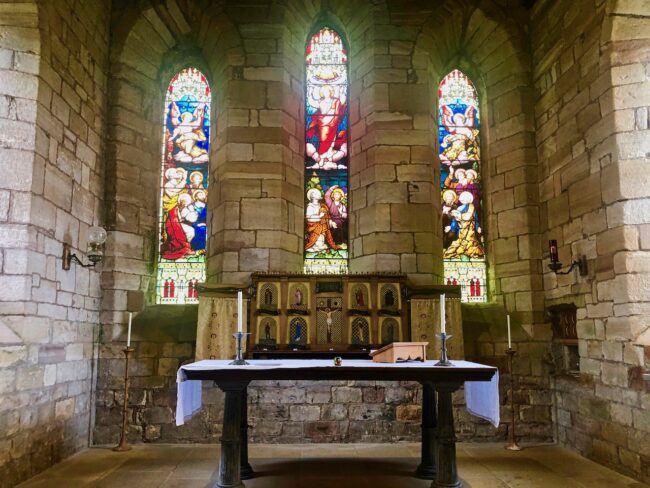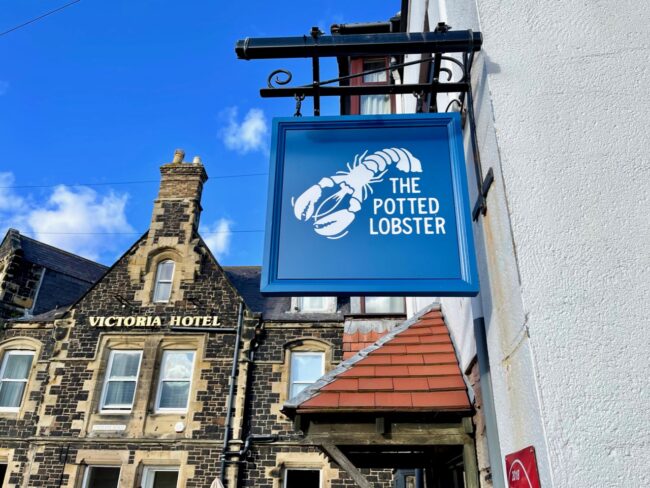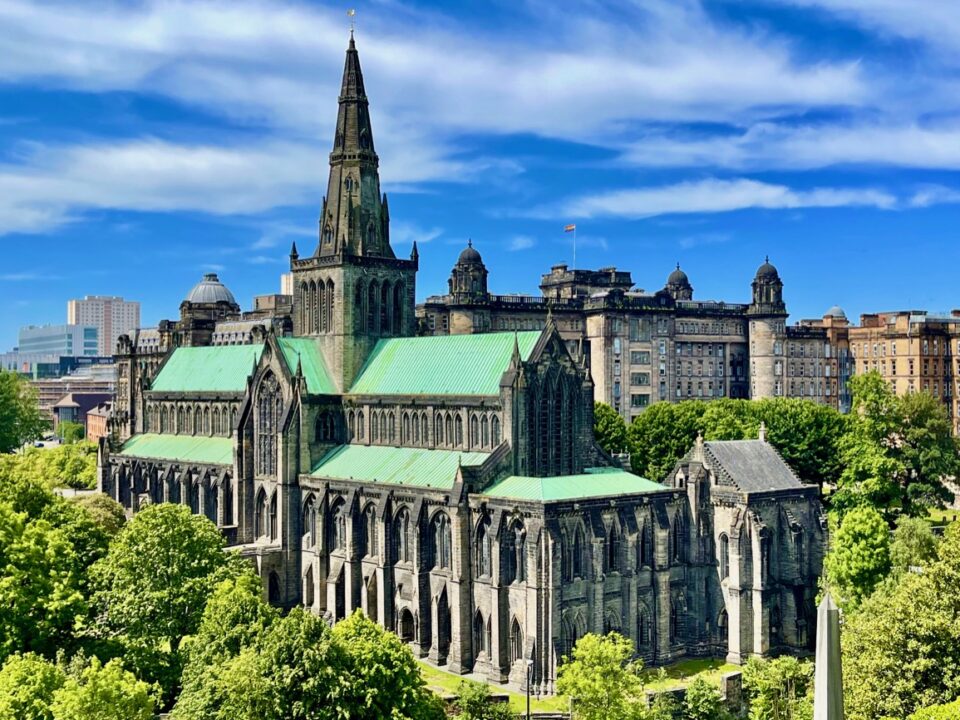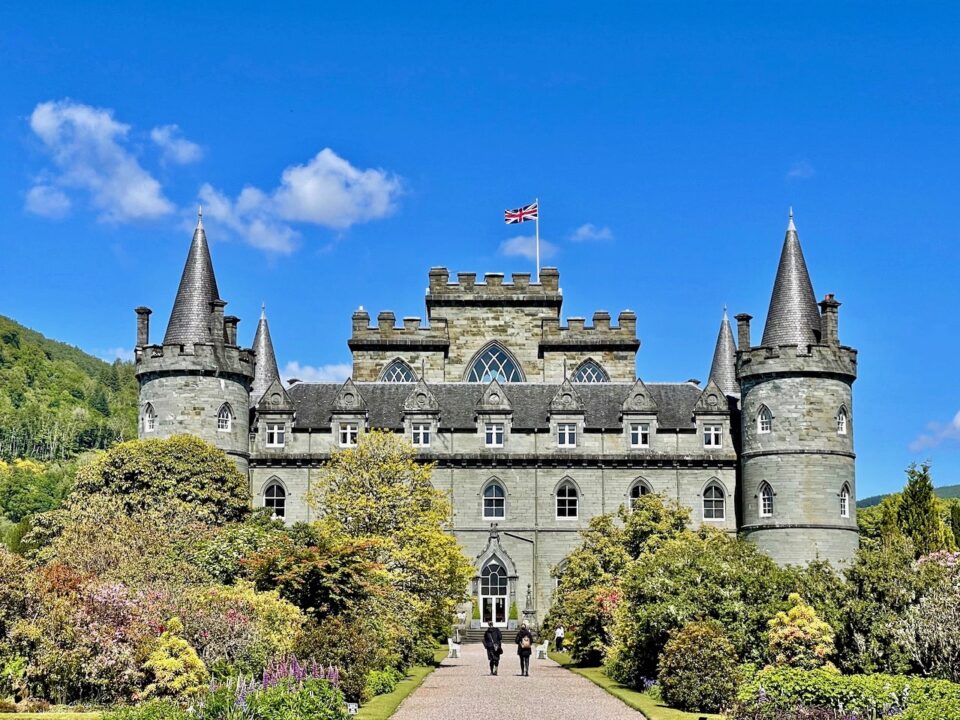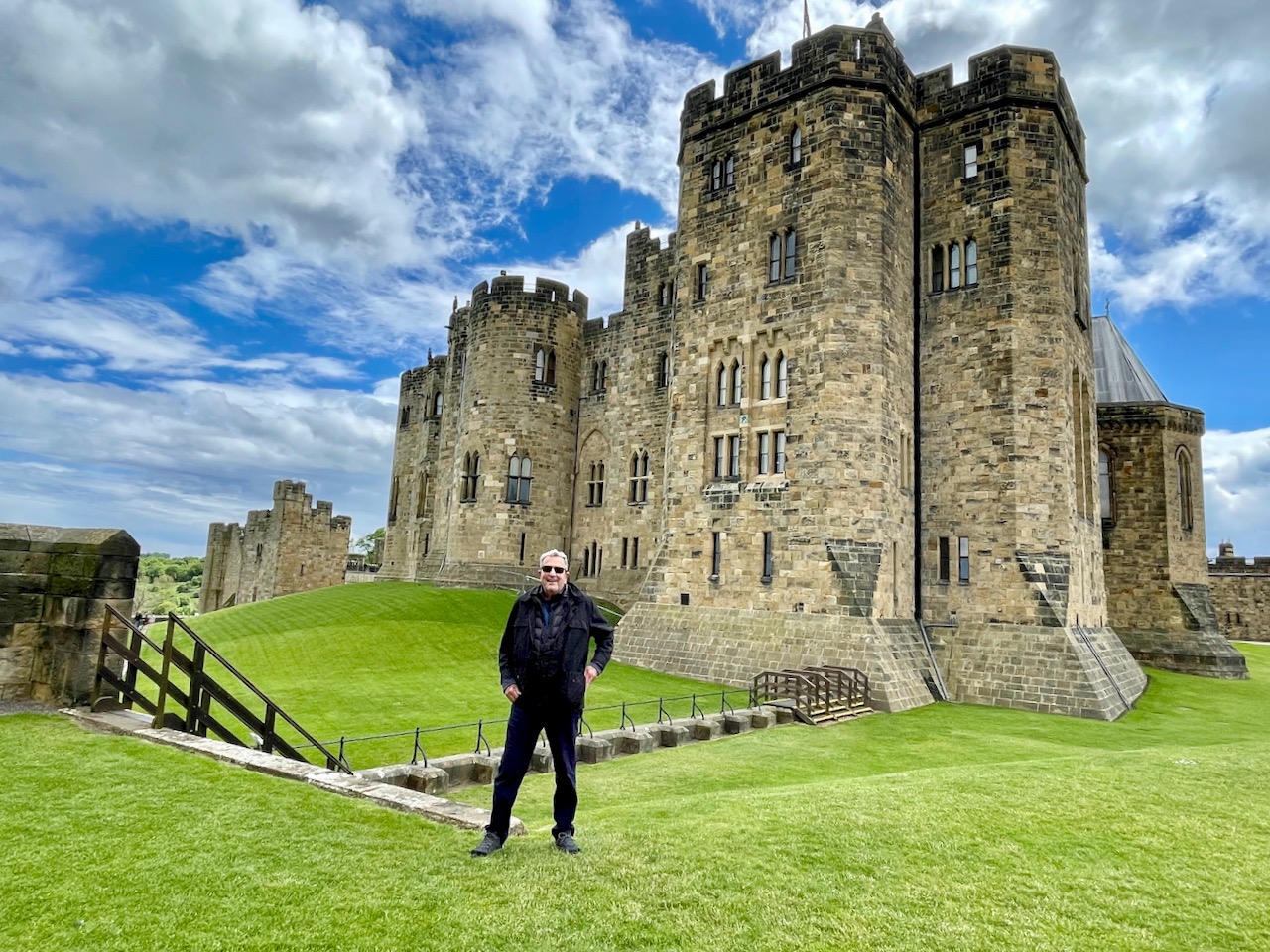
CHAPTER TEN: Trying Not To Get Poisoned In Alnwick
July 30, 2022
CHAPTER TWELVE: The Scottish Borders
August 10, 2022Surviving Mai Tai Tom’s “Royal” Blunder: 2022 England & Scotland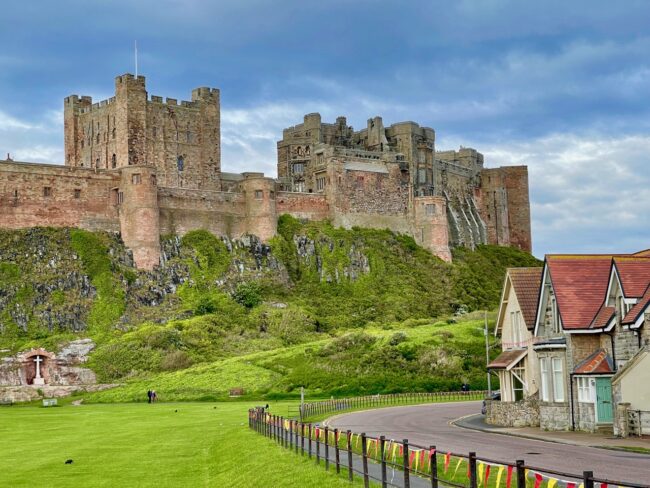
CHAPTER ELEVEN: Bamburgh Castle & Holy Island
Day Eleven: What The “H”, Another Visit With Lord Armstrong, Gunpowder, Kim & Mary Skip A Church, Saying Grace, Lean On Me, Waterfront Lunch, Low Tide, Dog Day Afternoon, Pick Up The Poop, Castle High, Against The Wind, A Priory Commitment, Could We Have That Recipe? and Getting Potted
After downing a plate of pancakes at Budle Hall B&B, we drove the short distance (5 minutes) to Bamburgh Castle. 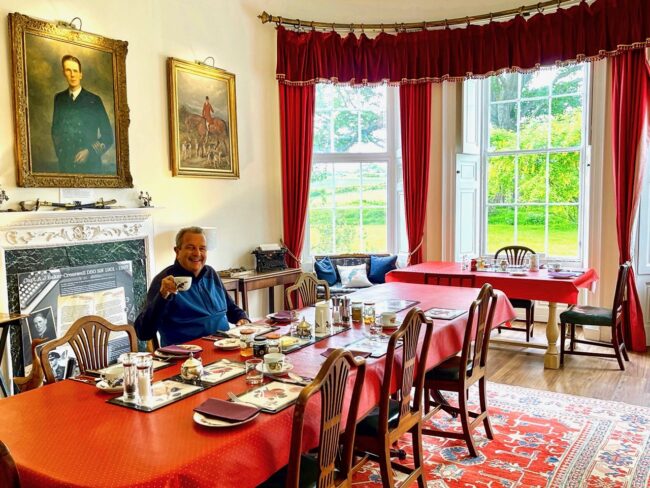
On the drive to the castle, we glanced at the sign designating what town we were entering. It read, “Bamburg.” I thought that was weird because I thought it was Bamburgh. We parked in the lot closest to the castle (hint: get here early to save a longer walk up) a couple of minutes before 10 a.m., when the castle opens.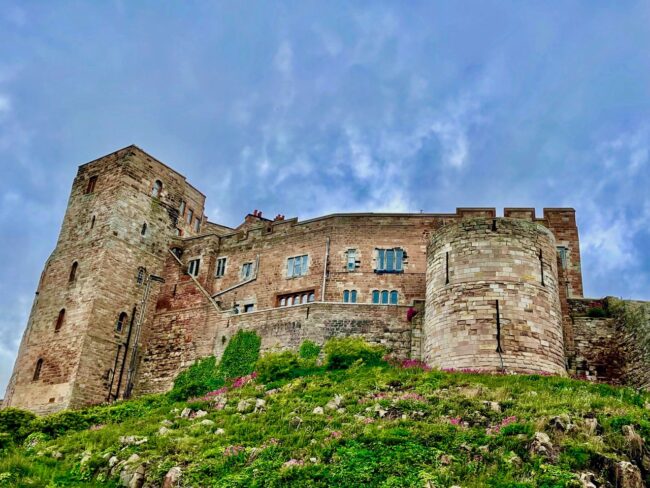
The current castle dates from the 12th century and was restored by the first Lord Crewe (so that’s where the restaurant gets its name) in the 1700s and the first Lord Armstrong, inventor, industrialist and benefactor, who we learned about at Cragside House, in the 1890s.
We walked out to take in the view from the castle out to the North Sea. Although Kim and I were out in the open, Mary provided us necessary cover.
The castle is located on top of volcanic rock. I felt there were enough cannons to make our visit here safe, although the first castle on this spot was destroyed in the 10th century.
We walked around the perimeter for a while to check it out from different angles.
Before entering, we saw the remains of The Chapel Of St. Peter. This is the spot that supposedly held the remains of St. Oswald (his arm anyway), who was a 7th-century “Northumberland Christian King” who was killed in battle in 642. 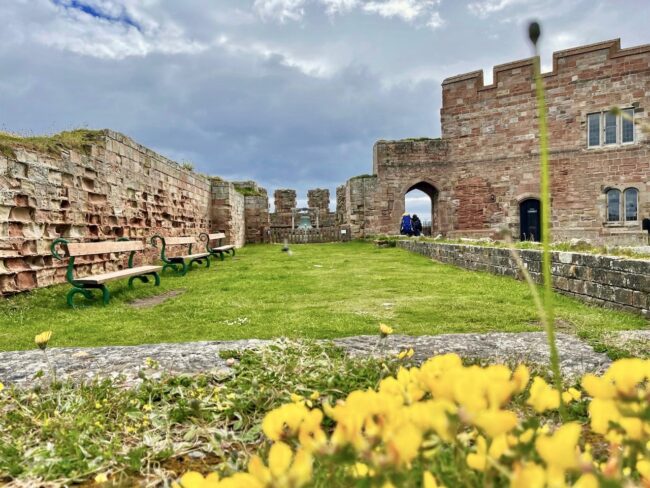
Nearby was the Bamburgh Castle Bell, originally on top of the clock tower known also as the Belle Tower. It remained there until the Fourth Lady Armstrong and nearby villagers grew “irritated due to its constant chiming.” By the way, the Armstrong family still owns Bamburgh Castle.
However, the most remarkable site we saw was a ring toss, which was memorable for the fact that Tracy got a ringer on her first (and only) toss (chronicled forever)
As we walked inside, I still that “Bamburg” sign on my mind. I asked the docent if Bamburgh is really spelled that way. “No,” she replied, “I guess the ‘h’ has worn away, and nobody has decided to replace it.” Mystery solved. I tried to quickly whisk Tracy away from the “Martha Stewart Collection” of china, but not before we learned that tea was introduced to Britain in the second half of the 17th century. You might not have wanted to drink it during that time as many thought tea drinkers were “frivolous, immorally stimulating and slanderous elves.”
There was a small replica of the castle as well as a video on the castle’s history, which, during the Wars Of The Roses, became the first castle in England to fall to cannon fire. Now those cannons out in front didn’t seem as protective.
In one of the 16 rooms we visited was a Sedan Chair that had a seat inside a cabin that two guys would carry by lifting two poles mounted to the sedan. I learned they were called ‘chairmen.” I asked the group that if a 2 x 4 was placed on top, would that make them Chairmen of the Board? They were glad there were only a dozen more rooms to go.
After that, the castle became much more interesting and beautiful. Through an arched doorway, we entered what is described as a “Victorian masterpiece,” The King’s Hall.
The King of Siam was a close friend of Lord Armstrong, and when he visited he helped to carve some of the designs in the room, which was utilized for receptions. Armor and paintings fill the hall.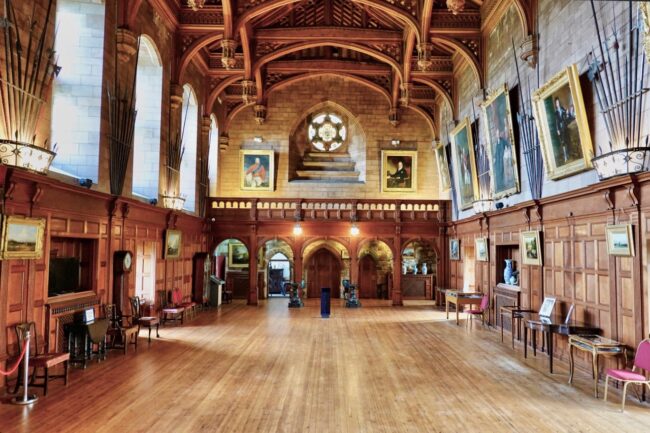
The teak used in the false beam hammer ceiling is from Siam. It’s good to have friends and ceilings in high places.
Looking from The King’s Hall, you see The Cross Hall.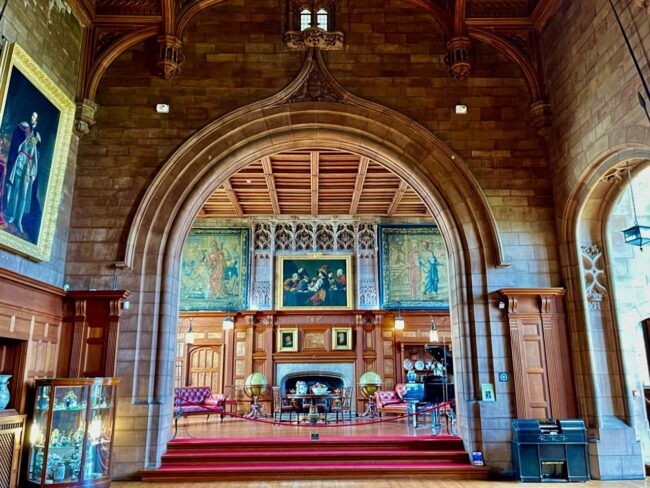
The Cross Hall is a really beautiful room that includes the painting about the fireplace entitled The Card Players which is a Dutch painting that is a “mirror image” of the one at a museum in Antwerp.
I’m guessing Lord Armstrong and his family would have enjoyed this room …
We headed through a hallway to the Billiard Room.
This is the site of the Medieval Royal Apartments.
It was used as a dining room in the early 1900s.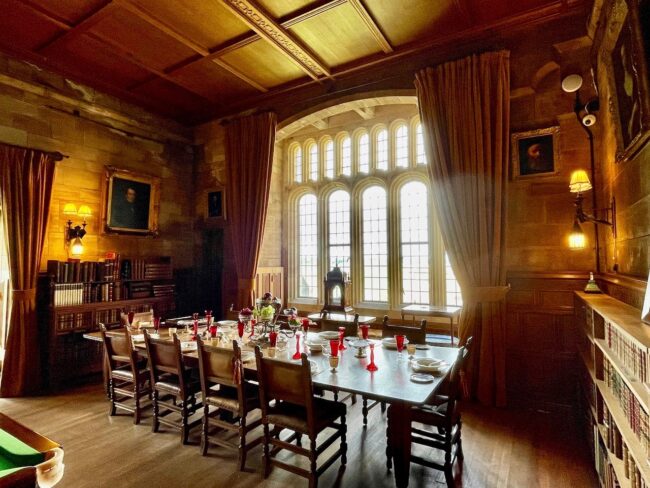
We were told to “Step back in time to the oldest parts of the castle.” First we checked out the Armoury.
I think the tapestry, chairs and medallion were in the Faire Chamber.
Next up was the Court Room, which has nothing to do with lawyers. It does have a 16th century metal Tuscan Marriage Chest. It was purchased for the bedroom of the 4th Lord Armstrong at his London apartment, but it wouldn’t fit through the door so it ended up here.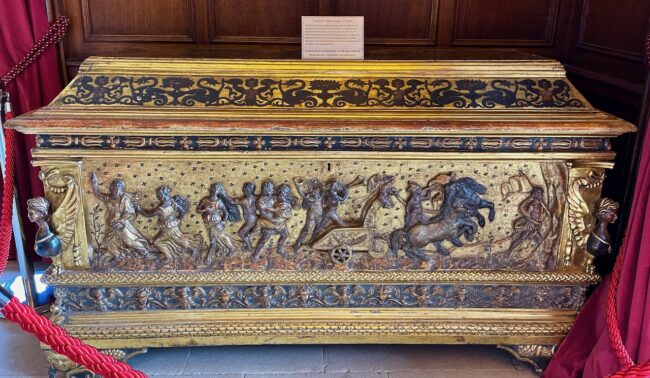
There were stops at The Bakery, which had a built-in brick oven …
… and the Scullery.
We were now in the Heart of the castle and The Keep Hall. This is the oldest surviving castle building, which dates back to 1164.
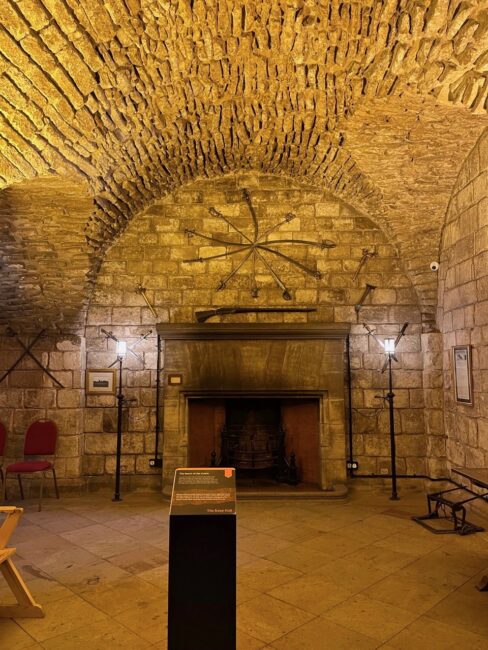 And here I thought I was the only knight in shining armor for Tracy.
And here I thought I was the only knight in shining armor for Tracy.
I guess it’s just not a castle without a little torture in the dungeon.
It must have been tough to live in medieval times. You risked life … and limb.
There were nice views out of some of the windows.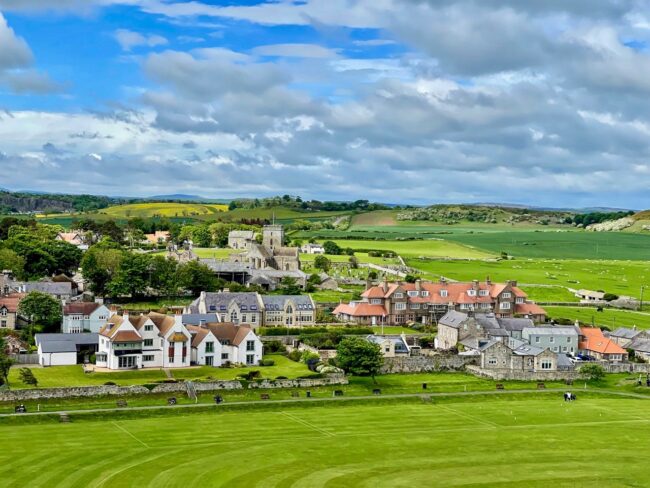
The Keep’s Hall walls are up to 11-feet thick.
I read, “A bottle- shaped doorway allowed soldiers on horseback to enter at a gallop without dismounting into the Keep Hall.”
It was such a clear day you could see all the way to Holy Island, where we’d stop later in the afternoon.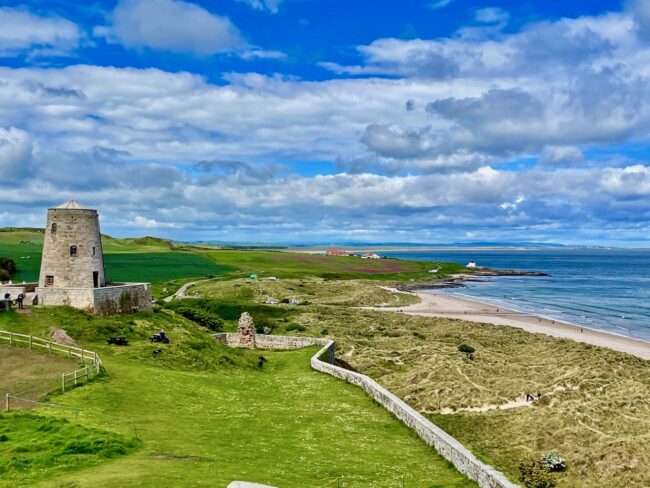
A large stone chair sat outside. This Anglo-Saxon stone chair goes all the way back to 800.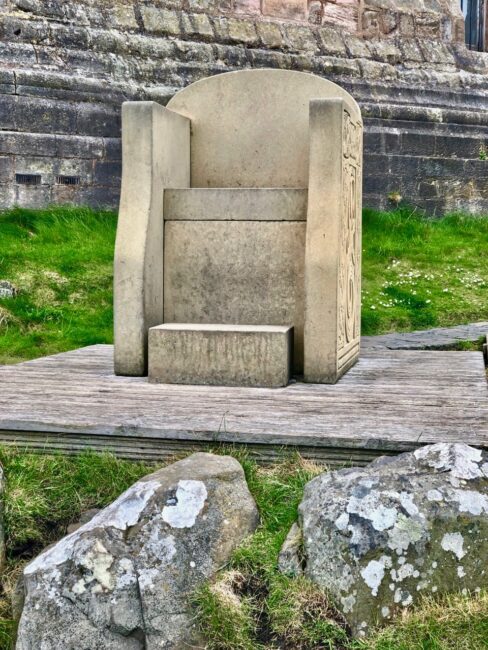
We could have walked a lot more on this pretty (and windy) day, but there were more places to see.
When Tracy and I said we wanted to scout out nearby St. Aidan’s Church, I could tell by the look on Kim and Mary’s face, they would not be joining us.
So while we walked around this 12th-century church, Kim and Mary checked out a nearby golf course.
First we explored the small cemetery on the grounds.
There was a church here in the 7th century, and St. Aidan supposedly died here while leaning against a “forked timber beam that supported the outside wall of the church.” That beam was the only part of the church that survived the 7th century fire. The beam forms part of the roof now and “became an object of veneration and was said to have miraculous healing properties.” Unfortunately, it did not help my injured arm.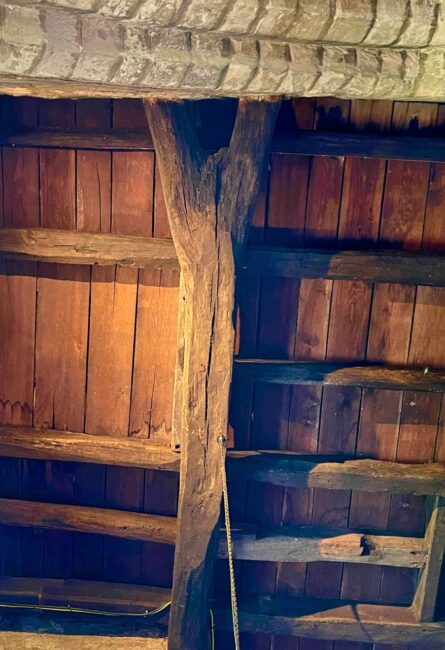
There is a shrine near to where it is believed St. Aidan died.
Also in the church is the Grace Darling Memorial. Darling, along with her father, helped rescue sailors from the wreck of the SS Forfarshire in 1838 after the ship ran aground in the Farne Islands during a fierce storm. Her effigy used to be outside, but erosion forced it to be relocated in the north aisle of the church. There is a Grace Darling Museum in Bamburgh, but I completely blanked and forgot to visit.
It was a pretty little church.
This piece told the story of St. Aidan and King Oswald. Because of an act of generosity by the king, St. Aidan grabbed his right arm and said, “May this hand never decay.” Even though Oswald was later killed, the story goes that his arm never corrupted.
Soon our ride came, and the four of us traveled to a town for lunch on the water, which is the northernmost town in England, although once upon a time it was part of Scotland. Because of the decline of the wool trade, Berwick-upon-Tweed had fallen on leaner times, so we were here to help out the local economy. It had at one time been called, “Alexandria of the North.” We took a quick walk on part of the town’s ramparts and fortified walls that were built during the reign of Queen Elizabeth I. I was warned, but carried on.
We got a nice view of the town at one vantage point.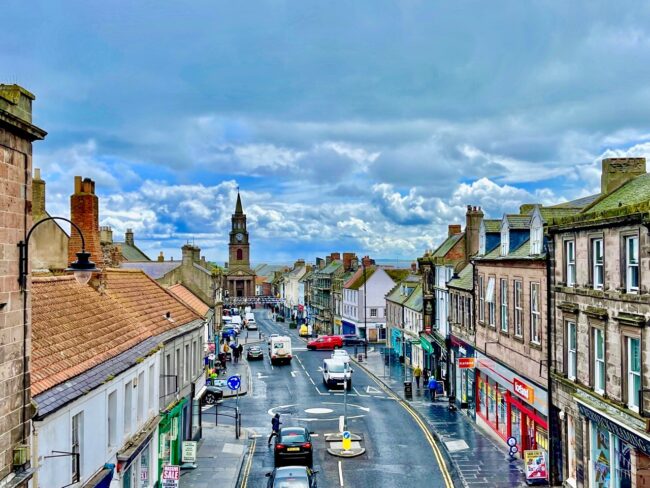
Before getting off the ramparts, we came upon a statue of a woman which commemorates Annie, Lady Jerningham, the wife and a one-time member of Parliament in the 1880s. She was also a philanthropist, and when she died at the age of 52 in 1902, shops throughout the city closed and residents shut their blinds.
On the water we spied a couple of bridges, the Berwick Bridge on the left and Royal Border Bridge on the right. They are two of the three bridges in Berwick.
The only time I can recall seeing this many Bridges was when I saw Lloyd, Jeff and Beau.
In true Bridges fashion, we also had our photos taken.
Then we had a nice lunch at Lowry’s at the Chandlery, a restaurant near the water recommended by our hosts at Budle Hall. They made a mean panini.
We left Berwick-upon-Tweed at about 2:15, which would get us to our next destination a little after 2:30. In a twist, had we tried to arrive before 2:30 we might have drowned. Our destination: Holy Island, home of Lindisfarne Priory and Lindisfarne Castle.
To get to the island, you have to cross a causeway that is only open at certain times of the day. It’s all up to the tide, and on this day low tide was scheduled to hit at 2:30. A sign warned us what would happen if you get stuck on the causeway during high tide. 
We hit the causeway at 2:37 p.m. and it was clear sailing … I mean driving. The parking lot is quite a distance from the castle, but first we walked through town, which I didn’t even know existed (so much for great planning). About 160 people reside on the island. I was so surprised, I forgot to take a photo (thank you Mr. Internet).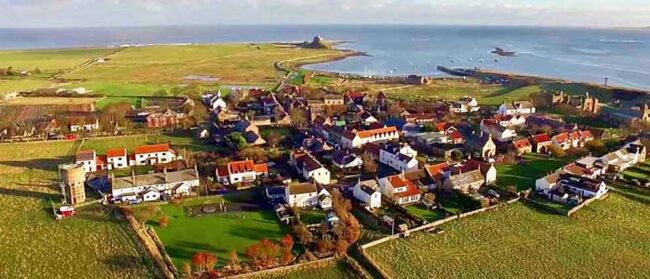
It was a good distance from town to the castle. It looks like a medieval castle, but it really is an early 20th-century restoration of a 16th-century castle. It’s a former fort that was turned into a holiday home. It is dubbed, “A castle (that’s not a castle) on an island (that’s not an island).” The founder of Country Life magazine, Edward Hudson, sought a “quiet retreat” from his London home.
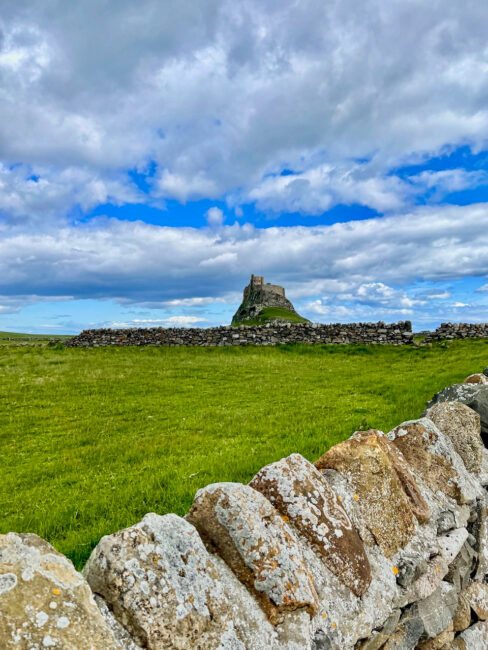 The winds were really whipping up, with the tail winds pushing us as we walked toward the castle.
The winds were really whipping up, with the tail winds pushing us as we walked toward the castle.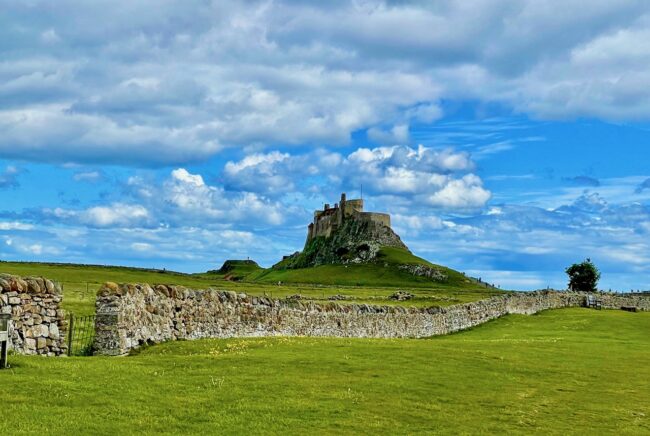
Here, like so many other places in England and Scotland, plenty of dogs were enjoying the afternoon.
This sign has nothing to do with the N.B.A.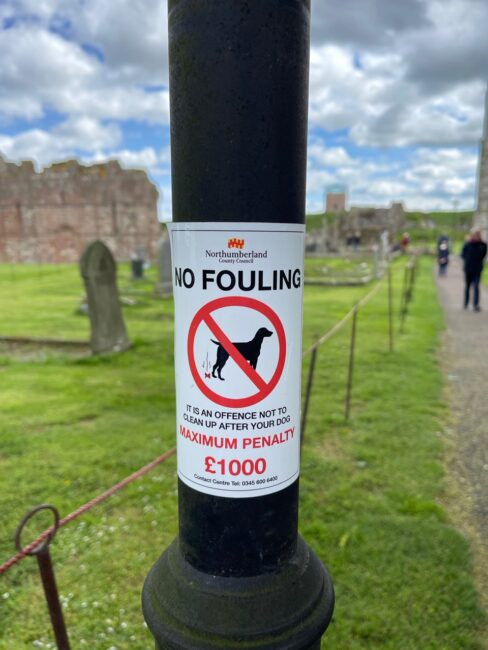
It was blowing hard as we approached the castle, and we took the requisite amount of photos.
We decided to pass on going inside and headed back toward the Priory.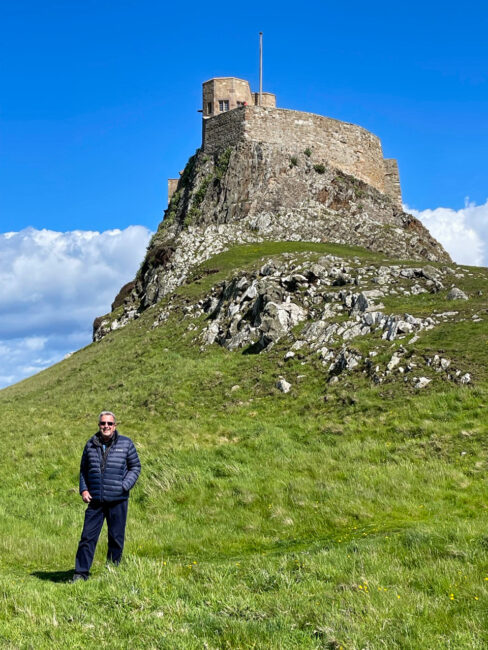 Bob Seger immediately came to mind as we walked Against The Wind to the Priory.
Bob Seger immediately came to mind as we walked Against The Wind to the Priory.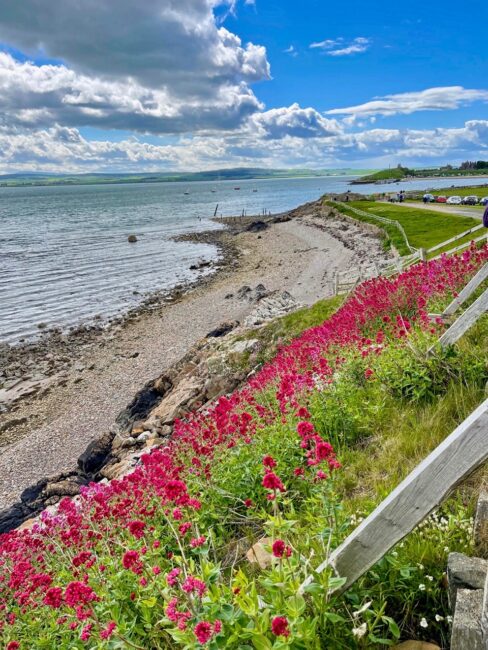
I said to Tracy, “It’s going to be hard for that large bird to get airborne.” She replied, “Yes, especially since it’s not real.” Wow, a castle that’s not a castle, an island that’s not an island and now a bird that’s not a bird. This is quite a place.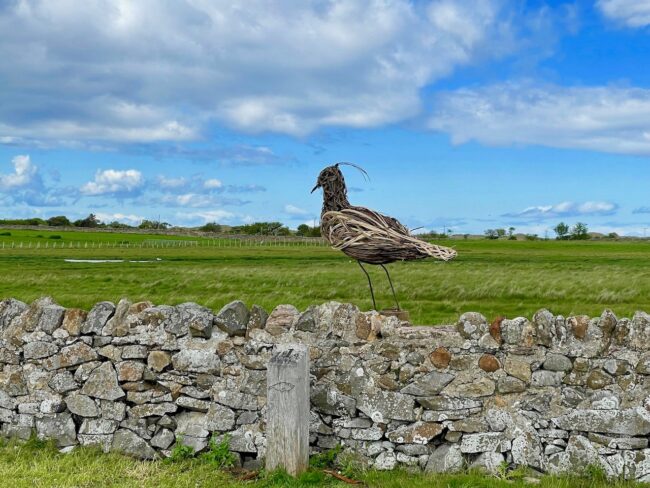
Lindisfarne Priory dates back to St. Aidan’s time in the 7th century. Bishop (later Saint) Cuthbert died here in 687, and 11 years after he died the body was exhumed and found to be “in a perfect state of preservation.” The monks had to get Cuthbert’s coffin out when they were getting sacked by the Vikings, something that happens often in Minnesota.
A new Priory church was built in the 12th century, but spoilsport Henry VIII closed it in 1537. It wasn’t destroyed by Henry VIII, but the ravage of time eventually did it in.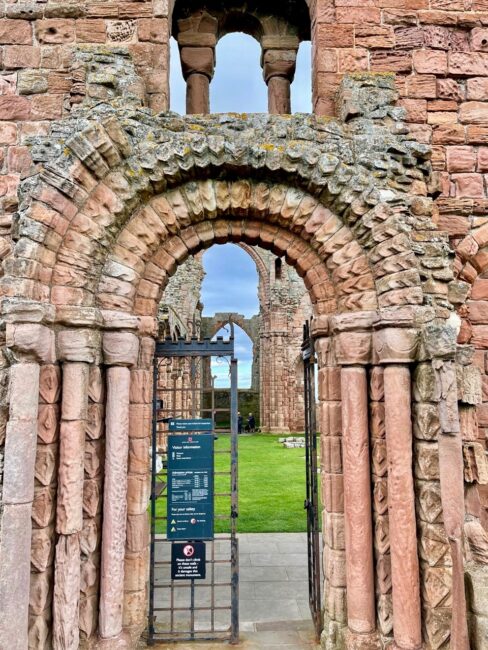
This is called “one of the great historic sights in England,” and the view to the castle is remarkable.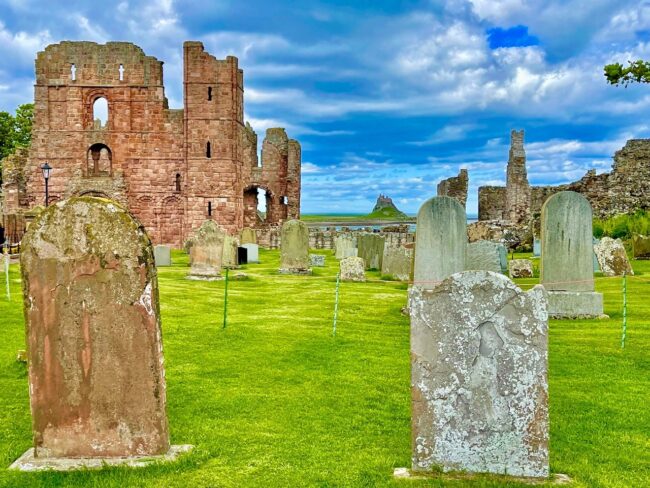
Nearby is St. Mary’s Parish Church, which is dwarfed by the ruins of the Priory, but it is actually much older than the Priory, being built in the 7th century.
We stopped briefly inside the ancient church.
Highlights were the stained glass at the east end of the church and The Journey, a carving by Fenwick Lawson, who created a number of statues around Durham in the 20th and early 21st centuries. It’s a sculpture that shows six monks carrying St. Cuthbert’s coffin from Lindisfarne to Durham. A 2008 bronze version of The Journey can also be seen at Durham’s Millennium Square. St. Cuthbert’s body eventually ended up at Durham Cathedral, having been removed from Lindisfarne to protect it from those Viking intruders.
Back at Budle Hall we were greeted by Ziggy, who looked like she had quite a day. 
We had our late afternoon tea and one of those scrumptious shortbread cookies. We could hold out no more and asked if we could get the recipe, and tomorrow morning we’d get it.
For dinner, we headed back to Bamburgh with an ‘h’ to the renowned The Potted Lobster, where we enjoyed yet another great meal (detailed here).
The following day we would head west to the Scottish Borders.
 Sadly, the castle we had wanted to explore would be closed for an event. However, we did get to tour its extensive gardens and take a hike from the gardens to at least see the exterior of the castle.
Sadly, the castle we had wanted to explore would be closed for an event. However, we did get to tour its extensive gardens and take a hike from the gardens to at least see the exterior of the castle.
Other stops along the way included a famous lookout, which had a view purported to be a favorite of a well-known Scottish novelist, a gigantic statue of William Wallace (aka Braveheart), and we’d end up at the “oldest continuously inhabited house in Scotland.”
Next: CHAPTER TWELVE: The Scottish Borders
Day Twelve: Kath’s Cookies, Fleurs At Floors, Scotland’s Largest Inhabited Castle (But Not By Us), Great Scott, Towering Braveheart, Burt’s, Farewell To Arms, The Agony Of De-Feet, In Search Of Mary Queen Of Scots, A Locals Restaurant and Masking Issues

